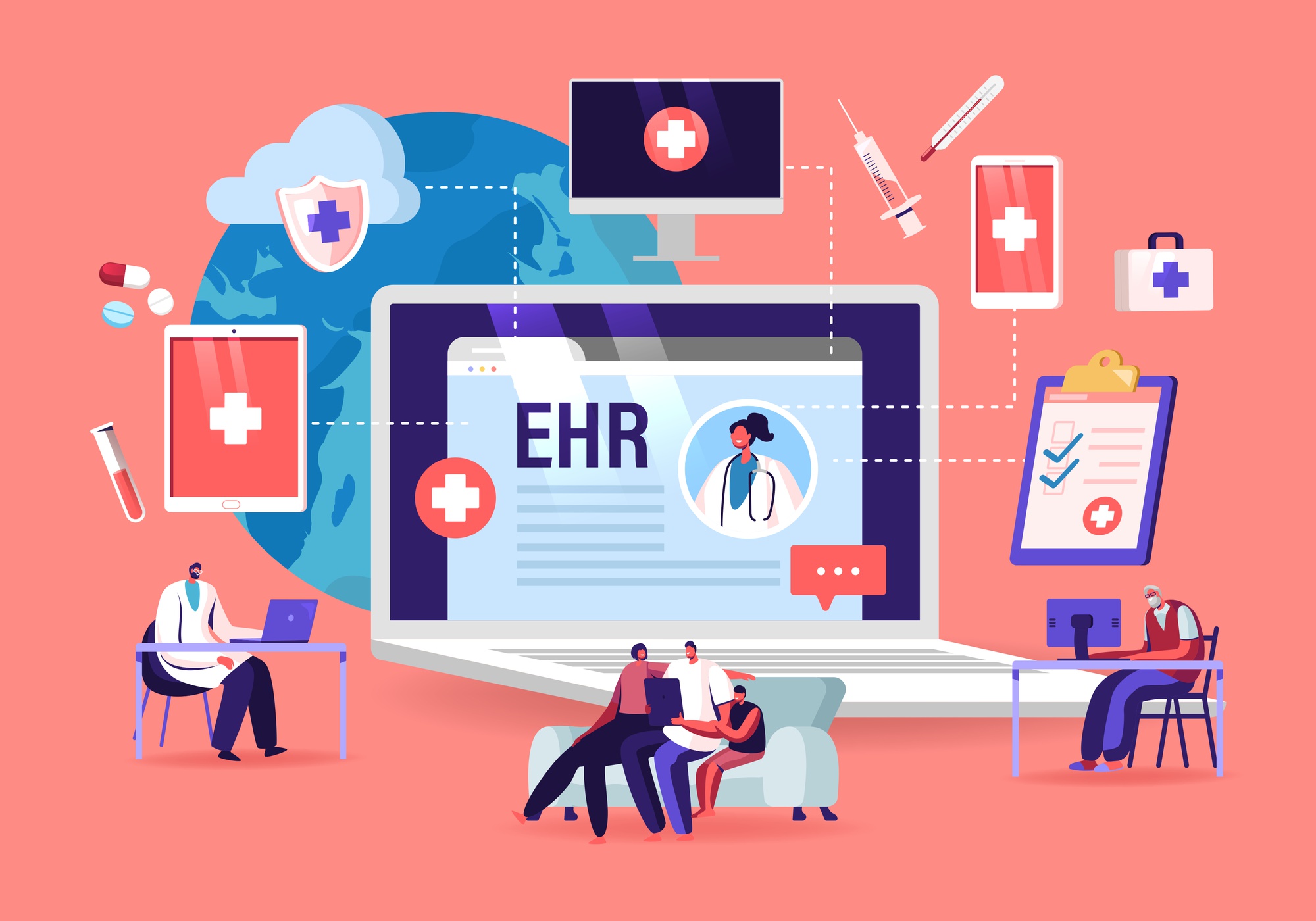EMR (electronic medical record) and EHR (electronic health record) interoperability is becoming a top priority for healthcare facilities worldwide. The market of interoperability healthcare solutions is forecasted to grow to $4.2 billion by 2024—almost twice as much as it was in 2019. Why is EHR interoperability important for medical organizations?
EHR/EMR interoperability means seamless access to health data for patients and healthcare providers through secure communication channels. The benefits include a higher level of care and patient satisfaction, as well as reduced operational costs.
This article explains how making your medical software interoperable can bring you improved service with cost savings. But first, let’s start with some basics.
What is EHR/EMR interoperability?

EHR/EMR interoperability is a system architecture that allows healthcare facilities to access, analyze, and share health data between systems, medical devices, and applications at a local or cross-organizational level.
So what is the goal of EMR interoperability?
Healthcare facilities use both custom and ready-made software to manage patient information and optimize healthcare processes. However, moving data between systems—either within the facility or between different organizations—can be challenging, as medical data from one solution can be unreadable for another. EHR interoperability ensures information portability and usability, meaning that medical data can be easily shared between different EHRs and providers.
Let’s see what benefits it can bring to the table. Read also: EMR Software Development Guide
Top 7 benefits of EHR interoperability for healthcare facilities

Interoperable software allows you to move healthcare data between disparate systems while maintaining its meaning. Here are five key ways this can benefit your medical organization.
1. Automation of redundant processes
Interoperable systems can eliminate time-consuming and redundant tasks because the EHR/EMR together with the analytics software will collect and process information from other systems automatically. According to InstaMed’s Tenth Annual Report, a staggering 87% of providers still leverage paper and manual processes for collecting data about patients. This results in numerous tedious tasks for medical staff and a high risk of errors in medical records.
To automate these processes, healthcare facilities can integrate appointment scheduling and medical billing software into their EHR/EMR platforms. In an interoperable platform with AI and machine learning tools, the data exchange in healthcare and analytic processes happen in the background, greatly reducing human errors. Automation also helps free up time, so medical staff can spend their time on what’s important—taking care of patients.
2. Cross-organizational communication
By implementing EMR/EHR interoperability, organizations can improve communications with other medical facilities. For example, clinics can send requests and receive e-prescriptions from pharmacies.
What’s more, by making their systems more open to data sharing, healthcare facilities can fill information gaps more quickly to get a complete picture of the patient’s condition. With EMR interoperability, accessing a patient’s longitudinal health records from other healthcare organizations is possible without spending too much time on phone calls, emails, and faxes.
3. Focus on the patient
A platform that adheres to EHR interoperability standards can actually make your facility more patient-centric. How?
Think about what people expect from healthcare today.
It’s all about convenience. People want to be able to move around the country freely while having their medical history easily available at the nearest hospital. What they don’t want is to have to wait to get their medical data from another facility.
Interoperable EHR systems allow health records to follow patients throughout healthcare systems. In other words, people can easily access their medical history and share it with new providers.
With this approach, people no longer have to give details of previous treatments or undergo repeat diagnostic procedures with every new doctor. They also enjoy a more coordinated, accurate, and productive healthcare experience. According to a 2020 study of the state of interoperability in healthcare, regular improvements to interoperability can increase patient satisfaction by 18% per year.
4. Scalable IT infrastructure
When upgrading, many healthcare providers have to reformat and migrate entire data sets, modules, and workflows to another platform due to EHR interoperability issues with new software. This makes the upgrade process time-consuming, not to mention expensive.
However, you can reduce costs with EMR interoperability since meeting EHR interoperability standards makes your platform compatible with new tools and software modules. As a result, you can add new solutions to your systems using fewer resources. For instance, you can easily upgrade your system with remote health solutions such as telehealth and remote patient monitoring (RMP).
5. Improved quality of healthcare
Traditionally, healthcare facilities develop care plans based solely on data monitored or recorded in a clinical setting. However, many other factors impact a person's health conditions. These include:
-
Health-related behavior, such as diet, exercise, sexual activity, and tobacco and alcohol use
-
A patient’s physical environment, such as air and water quality
-
Socioeconomic aspects, such as income and community and social support
Interoperable EHR systems can collect and analyze data from RPM devices—trackers and sensors that monitor a patient’s physical activity, blood pressure, glucose level, oxygen saturation, and even psychological health in their everyday life. With AI-powered analytical tools, providers can continuously monitor patient conditions, predict risks, and prevent complications.
Multi-specialty clinics can also improve care coordination with a unified EHR system. Patient care often involves many stakeholders (doctors, nurses, caregivers, and patients themselves) and a continuous flow of data. When relevant health information is shared seamlessly across different platforms (management, payment, diagnostics, and scheduling software), healthcare providers can deliver more effective care in less time.
6. Accurate diagnostics
A 2021 NCBI report on medical error reduction and prevention estimates that medical errors result in the injury or death of about 80,000 US patients every year. One of the most common medical errors is misdiagnosis, with 75% of the harm from diagnostics errors concerning people suffering from cancers, infections, and missed vascular events.
One cause of misdiagnosis could be a lack of information about a person’s health. Healthcare providers usually have their own patient records, and collecting them from other clinics is a long and overly complex process.
Imagine, instead, having a complete overview of a patient’s health records, including care preferences, past encounters, images, scans, and results of previous treatment. It’s reasonable to assume that a significant number of misdiagnoses could be prevented if providers can gather and analyze necessary information in time.
Access to EHR and EMR systems from other healthcare facilities helps providers understand the patient’s medical history more holistically and make more informed and accurate treatment decisions.
7. Reduced costs
As we’ve seen, interoperable EHRs and seamless data sharing can automate various repetitive processes, reduce human errors, and even improve healthcare quality.
Read also: How to Improve Data Quality in Healthcare
How does this translate into cost optimization? Here are six ways.
-
Healthcare companies and insurers can save money on repeat tests and procedures
-
Medical staff can serve more patients in the time saved on repetitive administrative tasks
-
Shareable EHR and EMR data reduce the need for trans-regional phone calls
-
There are fewer chances of malpractice lawsuits due to increased diagnostic accuracy
-
Improved customer satisfaction leads to better retention and higher profit potential
-
Fewer separate software upgrades and feature improvements result in savings on IT services
In summary, the interoperability of EHR/EMR systems can make your medical organization more effective and scalable. However, you should consider different levels of data portability to make this solution feasible for your facility.
Levels of healthcare systems interoperability

Interoperability as a concept has evolved over time. The Healthcare Information and Management Systems Society (HIMSS) previously outlined three types of data exchange: foundational, structural, and semantic. They then redefined the term in 2019 by adding organizational interoperability.
Let’s take a closer look at each type of interoperability.
Foundational
Foundational interoperability is the technical ability to exchange data between two health EHR systems or applications. At this level, the system won’t process the data. However, your software can send and receive data using secure communication channels.
Structural
EHR and EMR systems with structural interoperability can understand and interpret the data, but only at the data field level. For example, clinics can exchange data in the same format and process medication lists from pharmacies.
Semantic
Semantic-level interoperability means healthcare platforms can analyze patient information according to their underlying models. In other words, different EHR/EMR systems will automatically recognize terminology, medication symbols, coding value sets, and coding vocabularies to provide meaning to system users.
Organizational
The organizational level covers non-technical aspects of EHR system interoperability, such as social and administrative considerations, exchange policies, and legal processes. Organizational interoperability is necessary for the seamless and secure exchange of data between different healthcare providers and businesses.
According to 2019 HIMSS Media research, about 75% of healthcare organizations have progressed beyond foundational interoperability. However, only 36% have reached semantic interoperability, which is the desired level for the effective exchange of patient information between systems. Still, healthcare providers should strive to achieve organizational interoperability to ensure faster communication with partner organizations.
Now let’s see how software interoperability can transform the workflow in your organization.
Read also: Benefits of HL7 integration.
EHR interoperability use cases

What happens when a patient from another clinic schedules a visit at your facility? During the appointment, the doctor will hear about his problems and order lab tests. If the patient had tests recently, the doctor has three options:
-
Request documents from the relevant clinic
-
Send the patient to get their health records
-
Proceed with repeated lab tests either way
Usually, the last option is the fastest of the three, but it still delays examination and treatment.
What happens when your software platform adheres to EHR/EMR interoperability standards? Your physician can request a longitudinal view of previous encounters, treatment plans, medications, preferences, and lab test results in different hospitals. This allows them to plan treatment and medication lists even ahead of the appointment.
Interoperable systems can also eliminate manual entry, such as during infusion therapy. For example, data portability in EHR systems allows nurses to access the patient’s EHR with a click of a button and ensure that the infusion pump is programmed with the correct medication dosage.
The referral process becomes much easier as well when organizations have interoperable EHRs. In this situation, your physician can send key patient information to another clinic with a request for a referral and get an answer in the shortest possible time.
On top of all this, EHR system interoperability can improve readmission management. For example, remote patient monitoring software can help you track a patient’s condition after discharge and help distinguish between real risks and vague symptoms that don’t require in-person examinations. Additionally, you’ll understand why your customers are getting admitted to other healthcare facilities after discharge.
In short, interoperable software architecture can transform the entire healthcare landscape. However, many providers lack the expertise to enable interoperability in their EHRs and EMRs.
The challenges of creating an interoperable EHR system

EHR and EMR systems weren’t designed to process data from multiple sources. They usually have different interfaces, coding languages, data formats, and vocabulary. Because of this, about 36% of medical record administrations report having issues when exchanging health records. So, why do most medical facilities struggle to create interoperable systems?
Let’s look at the biggest EHR interoperability challenges for healthcare providers.
Quality and systematization of data
According to the 2020 HIMSS Media and Hyland Healthcare Survey, managing unstructured data is one of the most significant obstacles to improving interoperability. That’s because your system collects an enormous amount of data from different sources.
Let’s take allergies as an example. Information about the same allergy may exist in multiple electronic records, with different terminology in each record. This leads to many instances of duplicated data, which makes it harder for doctors to find relevant information.
Your organization can solve this issue by adopting a set of standards-based terminology and formats that will be easily analyzed and sorted by AI-powered tools. The FHIR (Fast Healthcare Interoperability Resources) is currently the most popular EHR interoperability standard on the market that offers structural and semantic interoperability. You can create your own FHIR implementation or hire an external company to optimize data for your EHR.
An unwillingness to share data
Some healthcare companies are reluctant to share EHR data despite industry efforts to facilitate patient’s access to electronic health information. Key industry players such as Epic Systems argue that new rules will create security concerns and privacy implications for patients.
What’s more, some facilities avoid interoperability because they feel it could threaten their business. A closed EHR (which is inaccessible to other providers) essentially helps lock patients into their system.
Data security
Nowadays, clinics can exchange health records and medical information through secure healthcare APIs, but only if they follow the FHIR standard.
However, EHR systems remain a prime target for hackers because they store volumes of personally identifiable information (including health, contact, and payment data) about patients and employees. According to Bitglass 2021 Healthcare Breach Report, healthcare breaches in 2020 exposed information from over 24 million patient records.
Read also: Data Security in Healthcare
Granted, data portability and interoperability can create new opportunities for hackers to get into your system. That’s why ensuring protection from data breaches in healthcare is a top concern. To achieve it, you need to:
-
Ensure your EHR adheres to security requirements and standards (HIPAA, IEC 62304, FDA, as well as federal and state laws)
-
Implement risk mitigation measures (such as data backup)
-
Conduct regular compliance assessments of safety technology solutions
-
Introduce role-based access control (restrict information for specific categories of employees) and authentication measures (two-factor and adaptive authentication)
-
Educate your staff and patients about the risks of data sharing
It’s critical to maintain patient trust and disclose what you will do with their health data. Consent models are usually dependent on the jurisdiction’s regulatory requirements. Regardless of the model you use, your patients should know when and how their health information is shared, and they should be able to revoke their consent at any time.
Lack of expertise
Implementing EMR interoperability is extremely challenging. A software development team has to assess and evaluate
-
The framework, workflows, technological specifications of your software
-
Dependencies and synergies across the platform
-
The mechanisms for data retrieval
-
Data management services (how the system systemizes and standardizes data from other software and EHRs)
-
Cybersecurity and encryption tools
Depending on the solution, engineers might have to reformat and standardize your existing data. Your workflow will also change as you add new third-party tools to your platform. This is why your organization will need to ensure regular maintenance of your interoperability architecture.
All this means that experience is a critical factor in software development for healthcare. You need a reliable team with relevant expertise to connect all business and clinical applications to your EHR/EMR systems and make the data exchange seamless and secure.
What's next?
Interoperability is the future of EHR and EMR systems. Interoperable platforms allow doctors, behavioral therapists, nurses, and consultants to access relevant health information and provide better services.
Providers without interoperable software and standardized medical data formats effectively lock patients into their systems. In contrast, as more and more patients are demanding more choice and freedom in their healthcare decisions, seamless data exchange between systems and organizations ensures a higher level of patient satisfaction.
Do you want to create a highly functional and future-proof EHR/EMR platform that complies with industry standards and local regulations? Demigos specializes in bringing unique healthtech solutions to the table. Our vetted team can make your data portable, secure, and easily accessible to patients and stakeholders. Contact us to learn more about EHR interoperability in healthcare.






